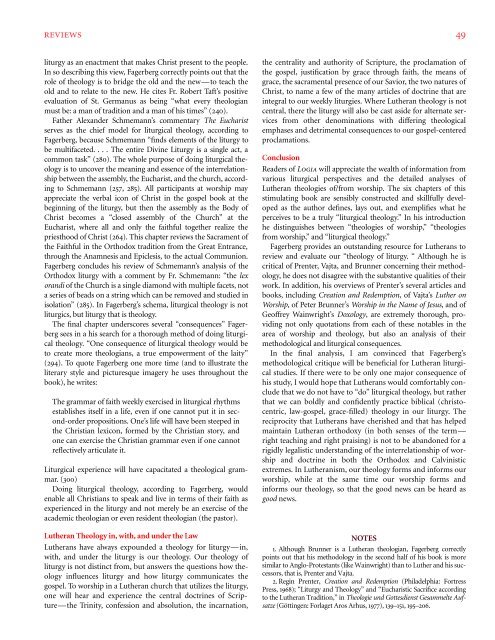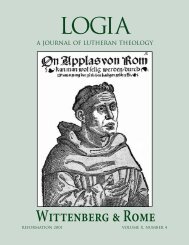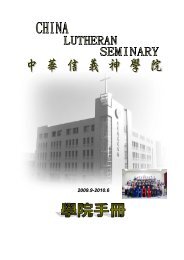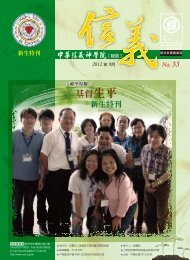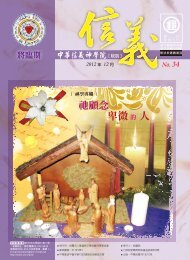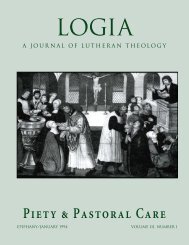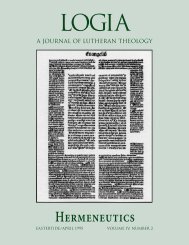05-4 Theology of the..
05-4 Theology of the..
05-4 Theology of the..
You also want an ePaper? Increase the reach of your titles
YUMPU automatically turns print PDFs into web optimized ePapers that Google loves.
REVIEWS 49<br />
liturgy as an enactment that makes Christ present to <strong>the</strong> people.<br />
In so describing this view, Fagerberg correctly points out that <strong>the</strong><br />
role <strong>of</strong> <strong>the</strong>ology is to bridge <strong>the</strong> old and <strong>the</strong> new—to teach <strong>the</strong><br />
old and to relate to <strong>the</strong> new. He cites Fr. Robert Taft’s positive<br />
evaluation <strong>of</strong> St. Germanus as being “what every <strong>the</strong>ologian<br />
must be: a man <strong>of</strong> tradition and a man <strong>of</strong> his times” (240).<br />
Fa<strong>the</strong>r Alexander Schmemann’s commentary The Eucharist<br />
serves as <strong>the</strong> chief model for liturgical <strong>the</strong>ology, according to<br />
Fagerberg, because Schmemann “finds elements <strong>of</strong> <strong>the</strong> liturgy to<br />
be multifaceted.... The entire Divine Liturgy is a single act, a<br />
common task” (280). The whole purpose <strong>of</strong> doing liturgical <strong>the</strong>ology<br />
is to uncover <strong>the</strong> meaning and essence <strong>of</strong> <strong>the</strong> interrelationship<br />
between <strong>the</strong> assembly, <strong>the</strong> Eucharist, and <strong>the</strong> church, according<br />
to Schmemann (257, 285). All participants at worship may<br />
appreciate <strong>the</strong> verbal icon <strong>of</strong> Christ in <strong>the</strong> gospel book at <strong>the</strong><br />
beginning <strong>of</strong> <strong>the</strong> liturgy, but <strong>the</strong>n <strong>the</strong> assembly as <strong>the</strong> Body <strong>of</strong><br />
Christ becomes a “closed assembly <strong>of</strong> <strong>the</strong> Church” at <strong>the</strong><br />
Eucharist, where all and only <strong>the</strong> faithful toge<strong>the</strong>r realize <strong>the</strong><br />
priesthood <strong>of</strong> Christ (264). This chapter reviews <strong>the</strong> Sacrament <strong>of</strong><br />
<strong>the</strong> Faithful in <strong>the</strong> Orthodox tradition from <strong>the</strong> Great Entrance,<br />
through <strong>the</strong> Anamnesis and Epiclesis, to <strong>the</strong> actual Communion.<br />
Fagerberg concludes his review <strong>of</strong> Schmemann’s analysis <strong>of</strong> <strong>the</strong><br />
Orthodox liturgy with a comment by Fr. Schmemann: “<strong>the</strong> lex<br />
orandi <strong>of</strong> <strong>the</strong> Church is a single diamond with multiple facets, not<br />
a series <strong>of</strong> beads on a string which can be removed and studied in<br />
isolation” (285). In Fagerberg’s schema, liturgical <strong>the</strong>ology is not<br />
liturgics, but liturgy that is <strong>the</strong>ology.<br />
The final chapter underscores several “consequences” Fagerberg<br />
sees in a his search for a thorough method <strong>of</strong> doing liturgical<br />
<strong>the</strong>ology. “One consequence <strong>of</strong> liturgical <strong>the</strong>ology would be<br />
to create more <strong>the</strong>ologians, a true empowerment <strong>of</strong> <strong>the</strong> laity”<br />
(294). To quote Fagerberg one more time (and to illustrate <strong>the</strong><br />
literary style and picturesque imagery he uses throughout <strong>the</strong><br />
book), he writes:<br />
The grammar <strong>of</strong> faith weekly exercised in liturgical rhythms<br />
establishes itself in a life, even if one cannot put it in second-order<br />
propositions. One’s life will have been steeped in<br />
<strong>the</strong> Christian lexicon, formed by <strong>the</strong> Christian story, and<br />
one can exercise <strong>the</strong> Christian grammar even if one cannot<br />
reflectively articulate it.<br />
Liturgical experience will have capacitated a <strong>the</strong>ological grammar.<br />
(300)<br />
Doing liturgical <strong>the</strong>ology, according to Fagerberg, would<br />
enable all Christians to speak and live in terms <strong>of</strong> <strong>the</strong>ir faith as<br />
experienced in <strong>the</strong> liturgy and not merely be an exercise <strong>of</strong> <strong>the</strong><br />
academic <strong>the</strong>ologian or even resident <strong>the</strong>ologian (<strong>the</strong> pastor).<br />
Lu<strong>the</strong>ran <strong>Theology</strong> in, with, and under <strong>the</strong> Law<br />
Lu<strong>the</strong>rans have always expounded a <strong>the</strong>ology for liturgy—in,<br />
with, and under <strong>the</strong> liturgy is our <strong>the</strong>ology. Our <strong>the</strong>ology <strong>of</strong><br />
liturgy is not distinct from, but answers <strong>the</strong> questions how <strong>the</strong>ology<br />
influences liturgy and how liturgy communicates <strong>the</strong><br />
gospel. To worship in a Lu<strong>the</strong>ran church that utilizes <strong>the</strong> liturgy,<br />
one will hear and experience <strong>the</strong> central doctrines <strong>of</strong> Scripture—<strong>the</strong><br />
Trinity, confession and absolution, <strong>the</strong> incarnation,<br />
<strong>the</strong> centrality and authority <strong>of</strong> Scripture, <strong>the</strong> proclamation <strong>of</strong><br />
<strong>the</strong> gospel, justification by grace through faith, <strong>the</strong> means <strong>of</strong><br />
grace, <strong>the</strong> sacramental presence <strong>of</strong> our Savior, <strong>the</strong> two natures <strong>of</strong><br />
Christ, to name a few <strong>of</strong> <strong>the</strong> many articles <strong>of</strong> doctrine that are<br />
integral to our weekly liturgies. Where Lu<strong>the</strong>ran <strong>the</strong>ology is not<br />
central, <strong>the</strong>re <strong>the</strong> liturgy will also be cast aside for alternate services<br />
from o<strong>the</strong>r denominations with differing <strong>the</strong>ological<br />
emphases and detrimental consequences to our gospel-centered<br />
proclamations.<br />
Conclusion<br />
Readers <strong>of</strong> LOGIA will appreciate <strong>the</strong> wealth <strong>of</strong> information from<br />
various liturgical perspectives and <strong>the</strong> detailed analyses <strong>of</strong><br />
Lu<strong>the</strong>ran <strong>the</strong>ologies <strong>of</strong>/from worship. The six chapters <strong>of</strong> this<br />
stimulating book are sensibly constructed and skillfully developed<br />
as <strong>the</strong> author defines, lays out, and exemplifies what he<br />
perceives to be a truly “liturgical <strong>the</strong>ology.” In his introduction<br />
he distinguishes between “<strong>the</strong>ologies <strong>of</strong> worship,” “<strong>the</strong>ologies<br />
from worship,” and “liturgical <strong>the</strong>ology.”<br />
Fagerberg provides an outstanding resource for Lu<strong>the</strong>rans to<br />
review and evaluate our “<strong>the</strong>ology <strong>of</strong> liturgy. “ Although he is<br />
critical <strong>of</strong> Prenter, Vajta, and Brunner concerning <strong>the</strong>ir methodology,<br />
he does not disagree with <strong>the</strong> substantive qualities <strong>of</strong> <strong>the</strong>ir<br />
work. In addition, his overviews <strong>of</strong> Prenter’s several articles and<br />
books, including Creation and Redemption, <strong>of</strong> Vajta’s Lu<strong>the</strong>r on<br />
Worship, <strong>of</strong> Peter Brunner’s Worship in <strong>the</strong> Name <strong>of</strong> Jesus, and <strong>of</strong><br />
Ge<strong>of</strong>frey Wainwright’s Doxology, are extremely thorough, providing<br />
not only quotations from each <strong>of</strong> <strong>the</strong>se notables in <strong>the</strong><br />
area <strong>of</strong> worship and <strong>the</strong>ology, but also an analysis <strong>of</strong> <strong>the</strong>ir<br />
methodological and liturgical consequences.<br />
In <strong>the</strong> final analysis, I am convinced that Fagerberg’s<br />
methodological critique will be beneficial for Lu<strong>the</strong>ran liturgical<br />
studies. If <strong>the</strong>re were to be only one major consequence <strong>of</strong><br />
his study, I would hope that Lu<strong>the</strong>rans would comfortably conclude<br />
that we do not have to “do” liturgical <strong>the</strong>ology, but ra<strong>the</strong>r<br />
that we can boldly and confidently practice biblical (christocentric,<br />
law-gospel, grace-filled) <strong>the</strong>ology in our liturgy. The<br />
reciprocity that Lu<strong>the</strong>rans have cherished and that has helped<br />
maintain Lu<strong>the</strong>ran orthodoxy (in both senses <strong>of</strong> <strong>the</strong> term—<br />
right teaching and right praising) is not to be abandoned for a<br />
rigidly legalistic understanding <strong>of</strong> <strong>the</strong> interrelationship <strong>of</strong> worship<br />
and doctrine in both <strong>the</strong> Orthodox and Calvinistic<br />
extremes. In Lu<strong>the</strong>ranism, our <strong>the</strong>ology forms and informs our<br />
worship, while at <strong>the</strong> same time our worship forms and<br />
informs our <strong>the</strong>ology, so that <strong>the</strong> good news can be heard as<br />
good news.<br />
NOTES<br />
1. Although Brunner is a Lu<strong>the</strong>ran <strong>the</strong>ologian, Fagerberg correctly<br />
points out that his methodology in <strong>the</strong> second half <strong>of</strong> his book is more<br />
similar to Anglo-Protestants (like Wainwright) than to Lu<strong>the</strong>r and his successors,<br />
that is, Prenter and Vajta.<br />
2. Regin Prenter, Creation and Redemption (Philadelphia: Fortress<br />
Press, 1968); “Liturgy and <strong>Theology</strong>” and “Eucharistic Sacrifice according<br />
to <strong>the</strong> Lu<strong>the</strong>ran Tradition,” in Theologie und Gottesdienst Gesammelte Aufsatze<br />
(Göttingen: Forlaget Aros Arhus, 1977), 139–151, 195–206.


